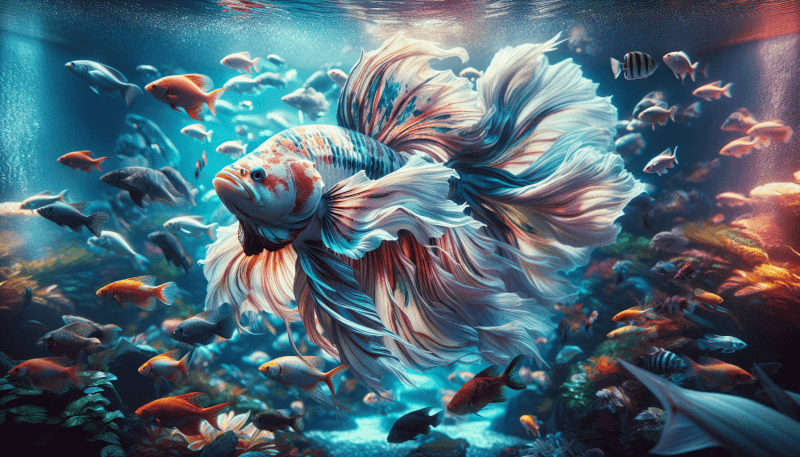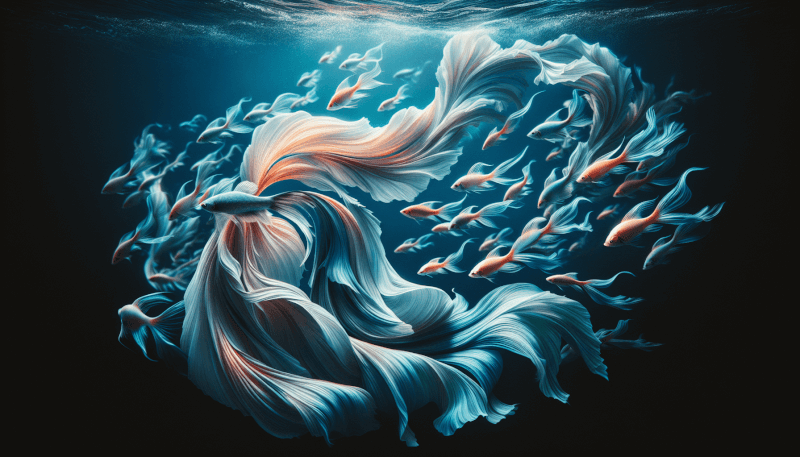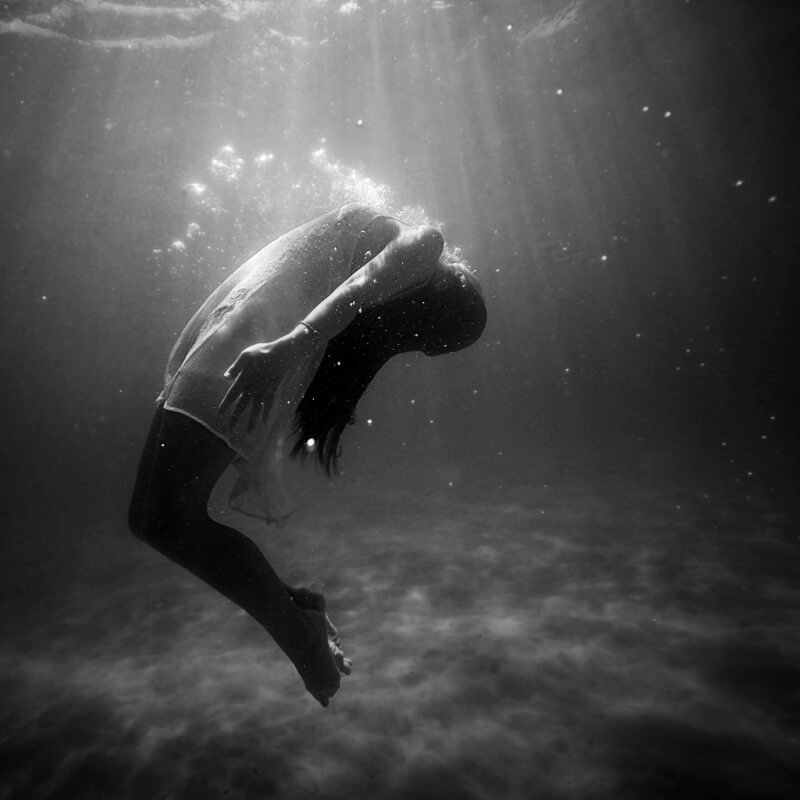Have you ever wondered how to make your aquarium come to life? In this article, we will explore the idea of incorporating a sense of motion and fluidity in aquarium aesthetics. By adding elements that mimic the natural movement of water and creating an environment that flows and evolves, we can enhance the beauty of our aquatic habitats. From the graceful sway of aquatic plants to the gentle glide of fish, we will discuss various techniques and design principles to create a visually stunning and dynamic aquarium. So, get ready to dive into the world of aquarium aesthetics and discover how to bring a sense of motion and fluidity to your underwater masterpiece!

I. Choosing the Right Fish and Plants
A. Selecting Fish with Graceful Movement
When it comes to creating a dynamic and visually appealing aquarium, choosing fish with graceful movement is key. Fish that possess fluid and elegant swimming styles can lend a mesmerizing charm to your aquatic landscape. Some popular options include angelfish, bettas, guppies, and neon tetras. These species showcase a range of swooping, gliding, and darting movements that add a sense of motion to your tank.
B. Incorporating Plants with Swaying Motion
Not only are plants essential for maintaining a healthy aquatic ecosystem, but they can also contribute to the overall sense of motion and fluidity in your aquarium. When selecting plants, consider those with soft and flexible leaves that naturally sway with the currents caused by your pumps or air stones. Examples of such plants include Anubias, Hornwort, and Vallisneria. Their gentle movement creates a calming and serene atmosphere.
C. Balancing Fish and Plant Choices
Creating the perfect balance between fish and plants is crucial in achieving a cohesive and harmonious aquarium design. Consider the swimming patterns and behavior of the fish you choose and how they interact with the plants. Some fish may enjoy hiding among dense foliage, while others may prefer open spaces for swimming. It is important to strike a balance that allows both your fish and plants to thrive while creating a visually appealing and dynamic environment.
II. Creating Dynamic Water Flow
A. Importance of Water Flow in Aquarium Aesthetics
Water flow is a crucial factor in creating a visually captivating aquarium. A well-designed flow pattern can bring life to your aquascape, enhancing the sense of motion and highlighting the natural movements of your fish and plants. Adequate water circulation also improves oxygenation and filtration, creating a healthier environment for your aquatic inhabitants.
B. Determining the Right Water Flow Rate
It is important to determine the right water flow rate for your aquarium, as excessive or insufficient flow can impact the overall aesthetics and functionality of your tank. Factors such as tank size, fish and plant species, and equipment setup should be considered when determining the ideal flow rate. Consulting with an experienced aquarist or researching the specific requirements of your fish and plants can help you strike the right balance.
C. Using Aquarium Pumps and Powerheads
Aquarium pumps and powerheads are essential tools in achieving dynamic water flow. They create currents and waves that simulate the natural environment of fish and plants. By strategically placing pumps and powerheads, you can generate flows that mimic rivers or ocean currents, adding a sense of motion and realism to your aquarium. Additionally, these devices promote water circulation, helping to distribute heat, nutrients, and oxygen throughout the tank.
D. Considerations for Placement of Pumps
When it comes to placing aquarium pumps, it is important to consider the specific needs of your fish and plants. Aim for a balanced distribution of water flow, ensuring that no area of the tank is stagnant or overly turbulent. Avoid directing the flow directly towards delicate plant leaves or fish that may struggle to swim against strong currents. Experiment with different pump placements to find the optimal arrangement for your aquatic landscape.
E. Creating Artificial Currents and Waves
To further enhance the sense of motion in your aquarium, consider creating artificial currents and waves. This can be achieved by strategically placing rocks, decorations, or driftwood to redirect the water flow. These features act as obstacles, creating areas of varying water movement and mimicking natural underwater landscapes. Not only do artificial currents add visual interest, but they also provide additional hiding places and exploration opportunities for your fish.
III. Utilizing Live Rock and Driftwood
A. Benefits of Live Rock in Aquascaping
Live rock, which is often used in saltwater aquariums, serves both as a decorative element and a functional component. It provides natural filtration and serves as a habitat for beneficial bacteria and other microorganisms. In terms of aesthetics, live rock adds texture, depth, and a sense of motion to your aquascape. Its uneven surfaces create nooks and crannies, allowing fish to swim through and creating interesting pathways.
B. Creating Caves and Overhangs
One effective way to incorporate motion into your aquarium is by creating caves and overhangs using live rock. These features not only offer hiding spots for fish but also provide opportunities for them to navigate through different levels of the tank. By strategically placing the live rock in layers or stacking it to create caves and overhangs, you can add a three-dimensional element to your aquascape and encourage natural behaviors in your fish.
C. Incorporating Driftwood for Natural Movement
Driftwood is a wonderful addition to any freshwater aquarium, bringing a touch of nature and a sense of motion to the underwater environment. The texture and shape of driftwood create interesting focal points and serve as anchor points for plants and mosses. As fish swim around or rest against the driftwood, it introduces a natural movement within the aquarium. Additionally, the tannins released by driftwood can create a soothing and earthy ambiance in the water.
IV. Adding Livestock for Motion
A. Including Fish with Schooling Behavior
Fish with schooling behavior, such as tetras, rasboras, and barbs, can add a captivating sense of motion to your aquarium. Watching them move as a synchronized group creates a mesmerizing spectacle. These fish naturally form tight groups, mimicking their behavior in the wild. By keeping an appropriate number of schooling fish, you can observe their coordinated movements and enjoy the visual flow they bring to your tank.
B. Incorporating Bottom Dwellers for Stirring of Substrate
Bottom-dwelling fish, like catfish and loaches, actively scavenge and sift through the substrate, contributing to the dynamic nature of your aquarium. As they navigate through the gravel or sand, they create small disturbances and stir up debris, mimicking the movement of underwater currents. Their constant activity adds vitality to the lower regions of the tank, making it visually interesting and preventing the substrate from becoming stagnant.
C. Selecting Invertebrates for Lively Interaction
Invertebrates, such as shrimp and snails, can be great additions to your aquarium, particularly for their lively and interactive behavior. Shrimp scuttle around and explore every nook and cranny, while snails glide gracefully along surfaces. Their constant movement and exploration contribute to the overall sense of motion in the tank. Additionally, some invertebrates, like certain types of crabs, exhibit unique movement patterns that can be visually captivating in an aquarium setting.

V. Enhancing the Illusion of Depth
A. Using Layering Techniques with Plants and Decorations
Creating an illusion of depth in your aquarium is a great way to enhance its visual appeal and sense of motion. Layering plants and decorations of varying heights and sizes can give the impression of different depths within the tank. Placing taller plants at the back and gradually transitioning to shorter ones towards the front creates the perception of distance and adds a dynamic quality to your aquascape.
B. Creating Perspectives with Varying Heights
Incorporating decorations of varying heights can also contribute to the illusion of depth. Items like rocks, caves, or driftwood that protrude above the water’s surface add vertical elements to your aquarium, drawing the eye upward and creating a sense of scale. By placing taller decorations strategically, you can establish multiple visual perspectives and further enhance the overall dynamism of your aquatic landscape.
C. Placement of Key Focal Points
To fully capture the attention and focus of observers, it is important to strategically place key focal points within your aquarium. These focal points can be achieved through the use of vibrant plants, distinctive rock formations, or captivating fish species. By placing these elements off-center or at prominent positions within the tank, you can create a sense of movement and draw viewers’ eyes to different parts of the aquatic environment.
VI. Harnessing Lighting Effects
A. Utilizing Light to Highlight Fluid Movements
Lighting plays a crucial role in accentuating fluid movements within your aquarium. By positioning lighting fixtures strategically, you can create shadows and reflections that enhance the sense of motion. For example, placing lights above or behind swaying plants can cast mesmerizing shadows on the substrate, mimicking the gentle swaying of underwater vegetation. Experimenting with lighting angles and intensities allows you to highlight the dynamic nature of your aquascape.
B. The Role of Colored Lighting
Colored lighting can add an enchanting and dramatic touch to your aquarium. By employing different colored bulbs or LED strips, you can evoke specific moods and enhance the visual impact of motion within the tank. Warm tones such as reds and oranges can create a vibrant and energetic atmosphere, while cooler tones such as blues and greens can evoke a serene and calm ambiance. Consider using colored lighting to accentuate specific areas or elements that contribute to the overall fluidity of your aquarium.
C. Moonlighting for a Tranquil Ambiance
Moonlighting, or the use of dim blue lights in the evening, can create a tranquil and captivating atmosphere in your aquarium. This type of lighting replicates the subdued lighting conditions of a moonlit night, allowing you to observe the graceful movements of your fish and the gentle sway of your plants in a calming environment. Moonlighting provides a peaceful contrast to the brighter lighting used during the day and can be an excellent way to unwind and enjoy your aquarium before bedtime.

VII. Incorporating Artificial Ornaments
A. Choosing Ornaments with Motion Elements
Artificial ornaments can be a valuable addition to your aquarium when seeking to enhance motion and fluidity. Look for ornaments that incorporate moving elements, such as rotating wheels, spinning decorations, or floating parts. These ornaments create additional points of interest, adding an element of surprise and animation to your aquascape. By carefully selecting ornaments that complement your fish and plant selections, you can further enrich the overall visual appeal and dynamic nature of your aquarium.
B. Factors to Consider for Safe Ornament Placement
While artificial ornaments can be visually appealing, it is important to ensure their safe placement within the aquarium. Consider the size and swimming capabilities of your fish when choosing and positioning ornaments. Make sure they do not create obstacles that impede the natural movement of your fish or cause entanglement. Additionally, ensure that the ornaments do not interfere with the flow of water or overshadow the beauty of your plants. Proper placement allows your ornaments to enhance the sense of motion and fluidity without compromising the safety and well-being of your aquatic inhabitants.
C. Using Air Stones and Bubble Walls
Air stones and bubble walls are practical and effective tools for creating motion in your aquarium. These devices release streams of tiny bubbles into the water, simulating the appearance of rising air or gentle underwater currents. By strategically placing air stones or bubble walls, you can introduce movement to your tank and create dynamic visual effects. These air-driven ornaments are versatile and easy to install, providing an effortless way to enhance the aesthetic appeal and overall motion in your aquarium.
VIII. Incorporating Moving Water Features
A. The Appeal of Moving Water in Aquariums
The addition of moving water features can create a stunning centerpiece and elevate the aesthetics of your aquarium. The sight and sound of cascading water or trickling streams can evoke a sense of vitality and serenity. Moving water features introduce a dynamic element and add depth to your aquascape, captivating both the eyes and the ears of viewers.
B. Types of Water Features to Consider
There are various types of water features you can consider incorporating into your aquarium to enhance motion and fluidity. Examples include cascading waterfalls, miniature fountains, or carefully designed streams. These features can be achieved using specialized aquarium accessories or custom-built structures. The choice of water feature should consider the size and layout of your aquarium, as well as the behavior and preferences of your fish.
C. Factors to Consider for Maintenance and Installation
Before incorporating moving water features, it is important to consider the maintenance and installation requirements. Water features may require additional equipment, such as pumps, filters, and tubing, which need regular cleaning and upkeep. The installation process should also be carefully planned to ensure proper functioning and avoid any potential leaks or malfunctions. Regular maintenance and monitoring are essential to ensure the longevity and functionality of the water feature, allowing you to continue enjoying its beauty and impact on the motion in your aquarium.

IX. Considering the Visual Flow of the Aquarium
A. Importance of Visual Flow in Aquarium Design
Visual flow is a crucial aspect of aquarium design that contributes to the overall aesthetic appeal and dynamism. It refers to the movement of the viewer’s eyes through the aquarium and the seamless transitions between different focal points. A well-considered visual flow guides the observer’s attention and ensures a captivating and harmonious viewing experience.
B. Creating a Sense of Continuity and Movement
To create a sense of continuity and movement in your aquarium, careful placement of plants, ornaments, and focal points is essential. Consider the natural behavior and swimming patterns of your fish when arranging their preferred hiding spots or swimming routes. Position plants and decorations in a way that leads the viewer’s gaze throughout the tank, creating a visual narrative. By encouraging the viewer’s eyes to travel in a smooth and fluid manner, you can maximize the impact of the motion and dynamism present in your aquarium.
X. Maintenance and Care for a Dynamic Aquarium
A. Regular Cleaning and Water Parameter Monitoring
Maintaining a dynamic aquarium requires regular cleaning and monitoring of water parameters. Clean the tank and remove any excess debris or waste regularly to prevent stagnation and maintain optimal water quality. Regularly test and monitor water parameters such as temperature, pH, ammonia, nitrite, and nitrate levels to ensure a healthy and thriving aquatic environment. Maintaining proper water conditions is essential for the well-being of your fish, plants, and the overall fluidity of your aquarium.
B. Pruning and Trimming Plants for Optimal Motion
To maintain optimal motion within your aquarium, it is important to regularly prune and trim your aquatic plants. Overgrown or decaying plants can hinder water flow and impede the natural movement of your fish. Trim dead leaves, thin out dense areas, and shape plants as needed to promote healthy growth and prevent obstruction. Pruning also allows for the constant evolution and redesign of your aquascape, ensuring that the sense of motion remains dynamic and visually appealing.
C. Adjusting Water Flow and Equipment Maintenance
Regularly adjusting the water flow in your aquarium can help to maintain a dynamic and visually pleasing environment. Observe the behavior of your fish and plants to ensure that the flow is not too strong or too weak for their preferences. Additionally, perform routine maintenance on aquarium pumps, powerheads, and other equipment to prevent malfunctions that may disrupt the fluidity of your tank. Regular cleaning, lubrication, and replacement of worn parts are necessary to ensure the efficiency and longevity of your equipment.


